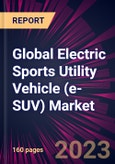1h Free Analyst Time
The electric sports utility vehicle (e-SUV) market is forecasted to grow by USD 83748.62 mn during 2022-2027, accelerating at a CAGR of 25.19% % during the forecast period. The report on the electric sports utility vehicle (e-SUV) market provides a holistic analysis, market size and forecast, trends, growth drivers, and challenges, as well as vendor analysis covering around 25 vendors.Speak directly to the analyst to clarify any post sales queries you may have.
The report offers an up-to-date analysis regarding the current market scenario, the latest trends and drivers, and the overall market environment. The market is driven by increasing demand and sales of bevs in global market, reducing prices of lithium-ion batteries, and growing government regulations, incentives, and subsidies on evs.
The electric sports utility vehicle (e-SUV) market is segmented as below:
By Propulsion
- Battery electric vehicle
- Hybrid vehicle
By Type
- Small
- medium size
- Large size
By Geographical Landscape
- APAC
- North America
- Europe
- South America
- Middle East and Africa
The report on the electric sports utility vehicle (e-SUV) market covers the following areas:
- Electric sports utility vehicle (e-SUV) market sizing
- Electric sports utility vehicle (e-SUV) market forecast
- Electric sports utility vehicle (e-SUV) market industry analysis
The study was conducted using an objective combination of primary and secondary information including inputs from key participants in the industry. The report contains a comprehensive market and vendor landscape in addition to an analysis of the key vendors.
The publisher presents a detailed picture of the market by the way of study, synthesis, and summation of data from multiple sources by an analysis of key parameters such as profit, pricing, competition, and promotions. It presents various market facets by identifying the key industry influencers. The data presented is comprehensive, reliable, and a result of extensive research - both primary and secondary. The market research reports provide a complete competitive landscape and an in-depth vendor selection methodology and analysis using qualitative and quantitative research to forecast the accurate market growth.
Table of Contents
PART 01: EXECUTIVE SUMMARYPART 02: SCOPE OF THE REPORTPART 03: RESEARCH METHODOLOGYPART 08: CUSTOMER LANDSCAPEPART 10: DECISION FRAMEWORK
PART 04: MARKET LANDSCAPE
PART 05: MARKET SIZING
PART 06: FIVE FORCES ANALYSIS
PART 07: MARKET SEGMENTATION BY VEHICLE SIZE
PART 09: REGIONAL LANDSCAPE
PART 11: DRIVERS AND CHALLENGES
PART 12: MARKET TRENDS
PART 13: VENDOR LANDSCAPE
PART 14: VENDOR ANALYSIS
PART 15: APPENDIX
List of Exhibits
Executive Summary
The publisher recognizes the following companies as the key players in the global electric sports utility vehicle (e-SUV) market: AEHRA, Bayerische Motoren Werke AG, BYD Co. Ltd., Dr. Ing. h.c. F. Porsche AG, Ford Motor Co., General Motors Co., Honda Motor Co. Ltd., Hyundai Motor Co., Kia Motors Corp., Mahindra and Mahindra Ltd., Maruti Suzuki India Ltd., Mercedes Benz Group AG, Nissan Motor Co. Ltd., Pravaig Dynamics Pvt Ltd., Renault SAS, Tata Motors Ltd., Tesla Inc., Toyota Motor Corp., Volkswagen AG, and Volvo Car Corp..Commenting on the report, an analyst from the research team said: 'The latest trend gaining momentum in the market is emergence of wireless charging systems for EVs.'
According to the report, one of the major drivers for this market is the increasing demand and sales of bevs in global market.
The study was conducted using an objective combination of primary and secondary information including inputs from key participants in the industry. The report contains a comprehensive market and vendor landscape in addition to a SWOT analysis of the key vendors.
Companies Mentioned (Partial List)
A selection of companies mentioned in this report includes, but is not limited to:
- AEHRA
- Bayerische Motoren Werke AG
- BYD Co. Ltd.
- Dr. Ing. h.c. F. Porsche AG
- Ford Motor Co.
- General Motors Co.
- Honda Motor Co. Ltd.
- Hyundai Motor Co.
- Kia Motors Corp.
- Mahindra and Mahindra Ltd.
- Maruti Suzuki India Ltd.
- Mercedes Benz Group AG
- Nissan Motor Co. Ltd.
- Pravaig Dynamics Pvt Ltd.
- Renault SAS
- Tata Motors Ltd.
- Tesla Inc.
- Toyota Motor Corp.
- Volkswagen AG
- Volvo Car Corp.








